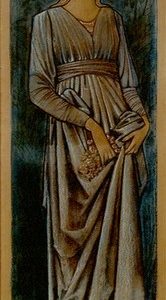For most Catholics, the name “St. Monica,” brings to mind the image of a holy and pious woman, most notable for her faithful, steadfast prayer that brought about the conversion of St. Augustine. Indeed, this image would be accurate, but there is so much more to learn from her life and put into practice in our own.
The first thing we can learn from Monica’s life is that what made her a saint was not that she never “messed up,” but that she picked herself back up and redoubled her efforts to try to do better. Early in life, Monica struggled with alcoholism. What’s more, it wasn’t until after she was caught that she worked to overcome the habit. It turns out, Monica started out as an “ordinary” person—just like us. God used her fall from grace to humble her, to enable her to recognize herself as “she who is not,” and to elevate her in holiness as she placed all her trust in “He who is” (St. Catherine of Siena).
Secondly, Monica was “given” in marriage; that is to say, she did not choose her husband. If there was any hope of falling in love with him, he would have destroyed that by his anger and infidelity. There was nothing “lovable” about her groom. Monica likely never felt love for her husband, but that does not mean Monica had no love for him. The love Monica had for her husband was one that was not dependent upon feelings of affection, but rather was one based solely upon an act of the will. Monica’s love for her husband was the purest love a soul could possibly have because it was a love that sprang forth from the love of God. It was the kind of love that would remain faithful to prayer for her husband’s soul right up until the day of his death.
The vast majority of Monica’s married years were spent in sorrow and pain. Perhaps most sorrowful of all for Monica was her husband’s refusal to allow their children to be baptized. She must have wondered, “Why would God allow me such suffering?” But without her difficult and trying circumstances, it is unlikely that Monica would have prayed as fervently as she did—for decades. And, historians tell us, it was through Monica’s persistence in prayer and good example that her husband was eventually converted. Shortly after his conversion, Monica’s husband died. His life’s purpose in God’s plan of salvation was now accomplished, but for Monica, there was more work yet to be done.
Her son, Augustine, was even more of a seemingly “lost cause” than her husband had been, as he was enmeshed in a hedonistic lifestyle, even boasting of his sexual exploits. Worst of all, Augustine abandoned the Christian faith in which he had been raised to embrace Manicheanism. St. Monica’s vocal prayers were primarily responsible for the conversion of her husband, but it seemed it would take even more than that to bring her wayward son back. What obtained the grace of conversion in the life of St. Augustine? The gift of St. Monica’s tears.
The child of those tears shall never perish. (St. Ambrose to St. Monica)
The gift of tears is a form of prayer, and it is perhaps the most efficacious prayer we have to offer for two reasons. One, it is an efficacious prayer because it is the prayer we offer when we have no words at all. In these times the Holy Spirt prays in us and through us, “com[ing] to the aid of our weakness; for we do not know how to pray as we ought, but the Spirit itself intercedes with inexpressible groanings” (Rom 8:26). And if it is the Holy Spirit praying for us…then we know that our prayer is already answered because God will only pray for that which He wills!
The second reason the gift of tears is the most efficacious prayer we have to offer is that it is a prayer of sorrow. Our sorrow over our circumstances is something that is just always there, underlying in our hearts, for as long as the circumstance that breaks our hearts has not been resolved. God can grant us peace in that sorrow, but it doesn’t mean that the sorrow goes away. Therefore, our shedding of tears is a way to “pray without ceasing” because we are continually sorrowful—and thus always praying—for that intention, which, paradoxically, is a cause for joy! Only in the Christian life can joy and sorrow coexist in the human heart in such a way.
Finally, one last lesson to learn from St. Monica’s life is that she didn’t just wait around for fifteen years, crying, until St. Augustine converted. She had a very important mission to accomplish during that time, and if she focused on her problems, she would never have had eyes to see what God was asking of her in that period of waiting:
Her patience and kindness became a source of encouragement to other unhappy housewives. (Whitney Hetzel, A Patron Saint for Finding Patience: St. Monica)
St. Monica could have spent a year praying and crying, and God could have decided, “You know what? One year is good enough. Time to zap your husband and firstborn with a shot of amazing grace!” That could have been the end of the story. But then what about the countless women whose only solace was the example of St. Monica, who understood what it was like to walk in their shoes and who had the grace to take the focus off herself so she could offer others the support and comfort they so desperately needed? We can imagine that her compassion, in turn, created a ripple effect to the circles of influence of the women she touched, thereby resulting in the conversion of not just two members of St. Monica’s own family, but that of countless others.
Through her husband’s anger and infidelity, the unkindness of her mother-in-law which she endured relentlessly (as they lived in the same house), the various women whose own painful marriages caused grief to Monica’s heart, and worst of all, the lack of faith in her children at the hand of their father…none of these agonizing trials brought Monica to seek relief in the alcoholic habit she’d worked hard to break years before. It would have been understandable—we might even say, to be expected. But the Lord’s eye was upon Monica. She brought her tears to Jesus to show Him her pain, and in turn, He brought her the solace and strength she needed in that moment to pick herself up and start again.
By her steadfast perseverance and unwavering trust, St. Monica changed the hearts of those around her, most especially that of St. Augustine…and thereby changed the course of history.
Well done, good and trustworthy servant; you have shown you are trustworthy in small things; I will trust you with greater; come and join in your master’s happiness. (Mt 25:23)
Scheffer, A. (1854). Saints Augustine and Monica [oil on canvas]. Retrieved from Wikimedia Commons.










